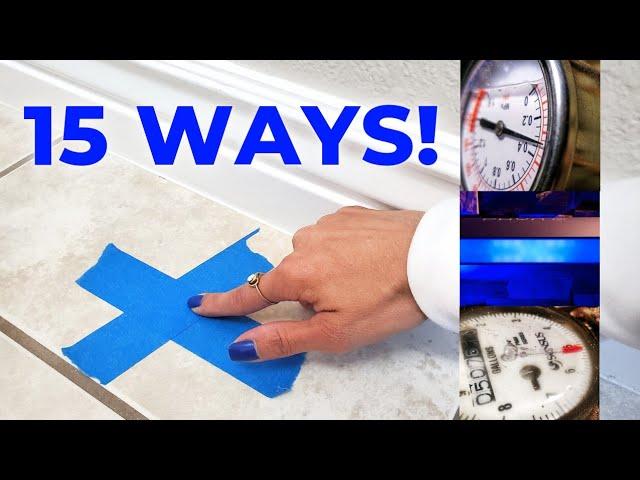
15 Ways to Detect a Plumbing Leak UNDER a Slab Foundation
Комментарии:

I have about 3 gallons a minute leak. Noticed my bathroom covered in cold water. Thought maybe sewer was backed up. Sucked water out and cut main off. When cut main back on nothing leaked in the house but water stains on foundation around the house where bathroom is located. Killed hot water tank and water still leaking so I have a cold water line leak somewhere in my bathroom area. Removed a large tree not to long ago and I guess that caused my house to shift. Sad
Ответить
Do you know what causes high sewer bills? It’s just me and my fiancé. Our water bill is only $20. But our sewage is $80.
Ответить
Great video! I always start out by isolating from meter to the main of the house its too bad a lot of times they have the crummy gate valves that dont always shutoff the water fully 🤨
Ответить
I’ve got one now. It’s in the washroom coming from the first 2 tiles of LVP flooring by the garage door. You can see the water spots in the concrete just below the garage door when you step into the garage. This makes like the 5th leak we have had in this house since we bought it. Unfortunately for us this house was built with recalled PEX and we missed the deadline to cash in on the class action suit. Now there is nothing we can do. It keeps happening. I absolutely hate it.
Ответить
I think I have a busted water pipe underneath my house will my meter still run slow if the water pipe is busted ?
Ответить
You need a South African Plumber to sort your issues out. Best in the world, hands down.
Ответить
Since you asked for it, here's our comment. Please accept my apology for its length, but we've been battling this for 8 years not totally successfully.
We bought a rancher in 2013 that was originally built in 1983 as our retirement home in the Houston area. It didn't have a moisture barrier in the foundation when it was built. It had carpet in poor condition. The foundation had been leveled and there were a lot of piers. We renovated the home extensively (including a metal roof) but didn't do anything to the foundation. We have a well and the water pressure fluctuates from 50 to 70 PSI. We replaced the carpet with vinyl flooring (flooring number 1). "Float" was used to level the floor over the piers. In some areas, the float never seemed to dry. The flooring starting coming up in multiple rooms and it was replaced with floating vinyl (flooring number 2). A thin pad was installed on the slab after re-leveling with float again and the vinyl planks interlocked on top. The planks came undone. When the pad was removed, the smell of mold was overwhelming. It was treated with sodium carbonate. A flooring engineer recommended engineered wood this time due to moisture in the slab. Engineered wood slab was installed (flooring number 3). In one bedroom, the several planks started disintegrating, starting with blisters in the finish. All attempts at repairing the wood failed. The outside wall in that room along the baseboard was wet the dry wall was wet. Through that wall was an air conditioning refrigerant line. The flooring seemed to do worse in the summer. I suspected that the damage was from the refrigerant line. A room dehumidifier pulled out gallons of water a day from that room. Our contractor, who had renovated that side of the house, said the problem was due to no weep holes in the bricks. There were no weep holes anywhere else on the foundation, so I was skeptical that was the cause, but I removed the mortar between every 3rd brick as instructed. It didn't seem to make a difference. Then Hurricane Harvey struck. Although there was a tremendous amount of rain (50 inches), the dehumidifier's output in that bedroom decreased and we also didn't get flooded. During the hurricane, although it was in August, it was substantially cooler. I asked our AC technicians to move the refrigerant line to run up the outside of the house into the soffit and not through the wall. They insisted on a foundation check first. We called the foundation people who leveled the house before we bought it. They did hydrostatic testing on all of the drain lines. *Everything was intact.* We had the refrigerant line relocated. The AC people found that the foam insulation around the line had deteriorated and the line was very wet. The moisture in that bedroom decreased. We then got another engineered wood floor installed in that room only (flooring #4 for that room). After about a year, dark lines started developing in that flooring. It looked like someone had drawn lines with a black sharpie, except nothing removed them (we tried water, floor cleaners, alcohol, acetone, mineral spirits and even lacquer thinner). The flooring people said that it was from moisture. During that time, a development was being built in our back yard on 13 acres (we didn't own that property, unfortunately). The development's property was initially below ours until they started building. Then they brought in many truckloads of dirt and mud and it is now elevated above ours. We complained to the city engineers who said that the development's property was actually sloped away from us, that it would not impact our property. We called our plumbers to look for a leak. The plumbers found no leaks in the fresh water system. They did hydrostatic pressure tests on the drain lines. We have 3 drain lines under the foundation, installed when the house was built. The foundation people had said that they were intact several years earlier. This time, our plumbers said that they had all broken off from under the slab! They had to tunnel under the slab to fix them. The cost was about $36,000 and homeowner's insurance only paid for about half of it. After the drain lines were repaired and brought up to code, we had the damaged floor in that room only replaced with porcelain tile (flooring number 5). We called in the foundation people again and had the foundation rechecked. They said it was fine, that it hadn't moved. I asked about whether the development in our back yard was responsible for the severed drain lines and they said it could have been caused by anything, not necessarily due to the development. I suspected that they just didn't want to get involved with a potential legal situation. The foundation guy explained that when the piers were placed to level the house, they went 20-30 feet into the ground. After a year, white-yellow moldy stuff started growing in the grout in that bedroom. A flooring specialist was brought in after the flooring people suggested treatment with phosphoric acid. The flooring specialist tested for moisture, found it to be high and said that nothing could be done about it, that it was "efflorescence." It does wash off easily with Bruce's, but we are now seeing it other areas of the house that still has the engineered wood flooring (flooring number 3 there). At this point, we don't know what to do other than just live with it.

We rent our duplex. Two weeks ago on Wednesday, one tile felt slightly warmer than the others in the small bathroom closest to the water heater (it also sounded hollow when i knocked on it, but that could be lack of adhesive on the back of the tile). Two days later, the floor felt very warm in the living room on the other side of the kitchen sink wall area, where it was carpeted. I’m talking heated floors type of warm. We were gone for the weekend and on Monday morning, the warmth spread further out in the living room towards the front door and in the kitchen, in front of the sink and counter where it was tiled (nothing was wet, though). I called our landlord to check it out and the soonest they could get there was 5:30pm. My girlfriend got home at 5pm and there was water everywhere!
Our landlord’s handyman supposedly found the source of the leak in the wall between the kitchen and living room. It’s a short wall with a little bar top on top. They capped it off and rerouted the hot water line via flex pipe up through the attic. They said they turned the hot water line off and then back on when they capped it to find the leak and couldn’t find any others. They also replaced the water heater. We’re getting recarpeted tomorrow, but i worry that they didn’t find the actual source and didn’t want to do the work or hire someone to find it. Our tile in the kitchen is still a little warmer than other parts of the kitchen, even a few tiles away, but not as bad as it was on Monday morning. Still a noticeable temperature difference being barefoot.
Looking back, i feel like there were symptoms. Occasionally, the pipes would rattle loudly in the middle of doing dishes and the water would shut off. I’d have to turn the faucet off and turn it back on to get the rattling to stop and the water flowing again. In the bathroom closest to the water heater, the hot water would shut off randomly (but pipes wouldn’t rattle). Another handyman looked and said that the hot water valve wasn’t open all the way, and that’s what was causing it. So he opened it. That was about a week or two before we noticed the warm floor. Could that have exacerbated the issue?

If the leaks are difficult to find, and most slab leaks are, hire a professional leak detector.
Ответить
Thank you from Mandurah, Western Australia.
Ответить
Pump compressed air From an air compressor at no more than 120 psi into the water lines the added noise from air escaping if there is a leak can make it easier to find the are of the nasty leak if it is in in a slab! Hint - Install a pressure gauge say where the PRV is located near the top of the tank to verify pressure! Note you can remove the prv put in a nipple and tee put the prv back in and install the gage and corresponding bushing into the side of the tee, leave the gauge in permanently! You may need to run air in to the lines for a couple of hours to find a leak. The more often the air compressor runs the bigger the leak, make sure you close the main cold water feed line from the city main. You can also purchase electronic leak detectors that respond to low levels of sound! If you have old poly B piping leaking bad news as time for it all to be replaced it has been banned for a number of years and is not covered by many insurance providers for leak damage. Since you can’t replace slab piping you will have to repipe in the house and may need to fur in the new pipes with drywall or whatever! Luckily not many homes have domestic water piping in slab it saves money up front but can cause big problems down the road!
Ответить



![Who is Mimi's adorable neighborhood friend? l The Manager Ep 221 [ENG SUB] Who is Mimi's adorable neighborhood friend? l The Manager Ep 221 [ENG SUB]](https://invideo.cc/img/upload/c2dNZFJ2OVFYQ2Q.jpg)





















